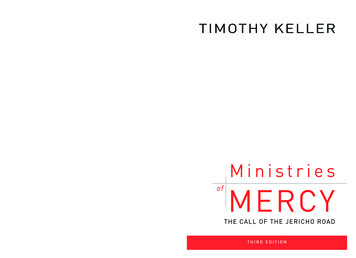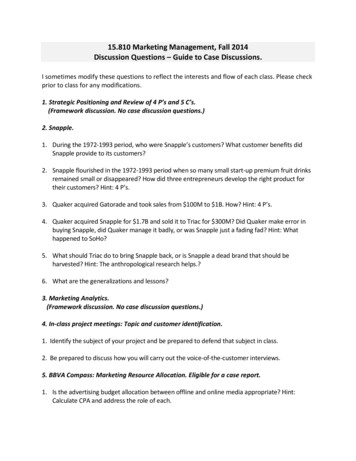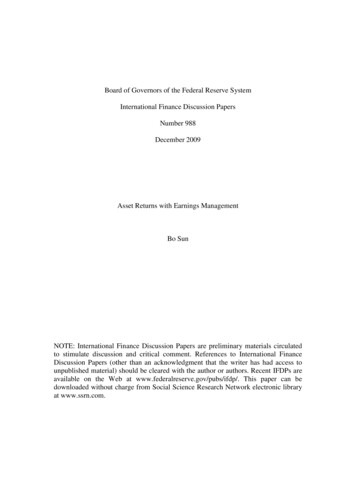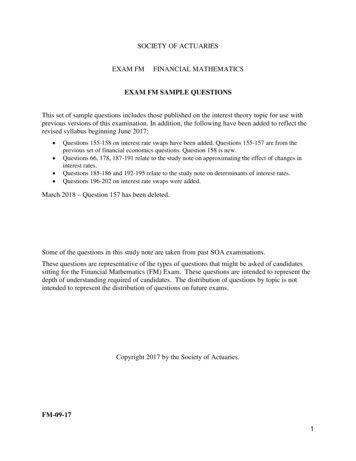
Transcription
INCLUDES DISCUSSION QUESTIONSAnd why would Jesus tell us, “Go and do likewise”?The Good Samaritan didn’t ignore the battered man on the Jericho road. Like him,we’re aware of people in need around us—the widow next door, the family strappedwith medical bills, the homeless man outside our church. God calls us to helpthem, whether they need shelter, assistance, medical care, or just friendship.Tim Keller shows that caring for these people is the job of every believer, asfundamental to Christian living as evangelism, discipleship, and worship. Buthe doesn’t stop there. He shows how we can carry out this vital ministry as individuals, families, and churches.Join Keller as he explores the biblical way to participate in compassion ministries. In this retypeset edition, he deals perceptively with thorny issues, such asbalancing the cost of meeting needs with the limits of time and resources, givingmaterial aid versus teaching responsibility, meeting needs within the churchversus outside the church, and more.“There was a point in my pastoral ministry when I looked for a steady hand on mineas I tried to navigate the swirling waters of mercy ministries in an urban setting whileremaining deeply committed to heralding God’s Word through the expositionof Scripture. Not surprisingly, I found it in Tim Keller’s Ministries of Mercy.”—JOHN PIPER, Founder and Teacher, www.desiringGod.org; Chancellor,Bethlehem College and SeminaryCHURCH MINISTRY / MISSIONS & OUTREACHISBN: 978-1-59638-955-7EANwww.prpbooks.com9 781596 38955751499KELLERTIMOTHY KELLER (MDiv, Gordon-Conwell Theological Seminary;DMin, Westminster Theological Seminary) is senior pastor of RedeemerPresbyterian Church in Manhattan and New York Times best-selling author ofThe Reason for God, The Prodigal God, and Prayer.MINISTRIES of MERCYWhy would someone risk his safety, upend his schedule, depletehis bank balance, and become dirty and bloody to help a personof another race and social class?
Keller Ministries of Mercy 3d Edition.indd 15/13/15 10:48 AM
Keller Ministries of Mercy 3d Edition.indd 25/13/15 10:48 AM
THIRD EDITIONKeller Ministries of Mercy 3d Edition.indd 35/13/15 10:48 AM
1989, 1997, 2015 by Timothy KellerThird edition 2015All rights reserved. No part of this book may be reproduced, stored in a retrievalsystem, or transmitted in any form or by any means—electronic, mechanical, photocopy, recording, or otherwise—except for brief quotations for the purpose of review orcomment, without the prior permission of the publisher, P&R Publishing Company,P.O. Box 817, Phillipsburg, New Jersey 08865-0817.Unless otherwise indicated, Scripture quotations are from the HOLY BIBLE, NEWINTERNATIONAL VERSION. Copyright 1973, 1978, 1984 International BibleSociety. Used by permission of Zondervan Bible Publishers.Scripture quotations marked (rsv) are from the Revised Standard Version of the Bible, 1946, 1952, 1971 by the Division of Christian Education of the National Councilof the Churches of Christ in the United States of America. Used by permission.Scripture quotations marked (kjv) are from the King James Version.ISBN: 978-1-59638-955-7 (pbk)ISBN: 978-1-59638-956-4 (ePub)ISBN: 978-1-59638-957-1 (Mobi)Printed in the United States of AmericaLibrary of Congress Cataloging-in-Publication DataKeller, Timothy J., 1950Ministries of mercy : the call of the Jericho road / Timothy Keller. -- Third Edition.pages cmIncludes bibliographical references.ISBN 978-1-59638-955-7 (pbk.)1. Corporal works of mercy. 2. Church and social problems. I. Title.BV4647.M4K45 2015253--dc232014047917Keller Ministries of Mercy 3d Edition.indd 45/13/15 10:48 AM
To Kathy,who had a social conscience firstKeller Ministries of Mercy 3d Edition.indd 55/13/15 10:48 AM
Keller Ministries of Mercy 3d Edition.indd 65/13/15 10:48 AM
ContentsEditor’s NotePrologue: The One Who Showed MercyIntroduction: Who Is My Neighbor?91117PART 1: PRINCIPLES1. The Call to Mercy2. The Character of Mercy3. The Motivation for Mercy4. Giving and Keeping: A Balanced Lifestyle5. Church and World: A Balanced Focus6. Conditional and Unconditional: A Balanced Judgment7. Word and Deed: A Balanced Testimony354561718599113PART 2: PRACTICE8. Getting Started9. Preparing the Church10. Mobilizing the Church11. Expanding Your Vision12. Managing Your Ministry13. Mercy Ministry and Church Growth14. Meeting NeedsRecommended ReadingKeller Ministries of Mercy 3d Edition.indd 71311431671892112252452555/13/15 10:48 AM
Keller Ministries of Mercy 3d Edition.indd 85/13/15 10:48 AM
Editor’s NoteMinistries of Mercy was written in 1988 as part of a research project forthe Presbyterian Church in America. Many of the statistics have changedsince that time, but the underlying principles—and needs—remain. Ourdesire is that this book and the principles of mercy ministry it discusseswill aid you in the service of your church and city.Some excellent resources have become available since this book’soriginal publication. Several of these are listed under RecommendedReading at the back of this new edition.9Keller Ministries of Mercy 3d Edition.indd 95/13/15 10:48 AM
Keller Ministries of Mercy 3d Edition.indd 105/13/15 10:48 AM
PROLOGUEThe One Who Showed MercyOn one occasion an expert in the law stood up to test Jesus. “Teacher,”he asked, “what must I do to inherit eternal life?”“What is written in the Law?” he replied. “How do you read it?”He answered: “ ‘Love the Lord your God with all your heart andwith all your soul and with all your strength and with all your mind’;and, ‘Love your neighbor as yourself.’ ”“You have answered correctly,” Jesus replied. “Do this and youwill live.”But he wanted to justify himself, so he asked Jesus, “And who ismy neighbor?”In reply Jesus said: “A man was going down from Jerusalem toJericho, when he fell into the hands of robbers. They stripped himof his clothes, beat him and went away, leaving him half dead. Apriest happened to be going down the same road, and when he sawthe man, he passed by on the other side. So too, a Levite, when hecame to the place and saw him, passed by on the other side. But aSamaritan, as he traveled, came where the man was; and when hesaw him, he took pity on him. He went to him and bandaged hiswounds, pouring on oil and wine. Then he put the man on his owndonkey, took him to an inn and took care of him. The next day hetook out two silver coins and gave them to the innkeeper. ‘Lookafter him,’ he said, ‘and when I return, I will reimburse you for anyextra expense you may have.’“Which of these three do you think was a neighbor to the manwho fell into the hands of robbers?”The expert in the law replied, “The one who had mercy on him.”Jesus told him, “Go and do likewise.” (Luke 10:25–37)11Keller Ministries of Mercy 3d Edition.indd 115/13/15 10:48 AM
12PrologueTHE DANGEROUS ROADThe road to Jericho is steep and dangerous. So dangerous, in fact,that people called it “the bloody way.” Jerusalem rests at 3000 feet abovesea level, while Jericho, only seventeen miles away, sits on land 1000feet below the level of the Mediterranean. The road between the townsdescends sharply through mountainous territory full of crags and caves,allowing thieves to hide, strike, and escape with great ease. Travelingthe Jericho road in those days was very much like walking through adark alley in the worst part of a modern city, except that it was manymiles to the nearest streetlight.In this “dark alley” a man fell victim to a social problem—crime.“He fell into the hands of robbers. They stripped him of his clothes,beat him and went away, leaving him half dead” (v. 30).THE TWO WHO WALKED BYA priest and a Levite soon came along in turn, and each passedby on the far side of the road, not wishing to become involved in theman’s needs.We should not be too quick to scorn these men, or we may discoverwe are convicting ourselves. Consider how you might react if you wereanxiously taking a shortcut through a dark alley. Imagine that you seea groaning man on the ground, conclusive evidence that a maraudingband of thugs is watching you around the corner! Surely the wisest thingto do is to hurry on to safety and send some official to look after thepoor victim. So you run.There may have been another, very “religious” reason for the priestand Levite to avoid the man. Levitical law declared that anyone touchinga dead body was ceremonially “unclean” (Num. 19:11–16), excludinghim from worship ceremonies for seven days. What if this man werealready dead, or about to die anyway? How easy it would have been forthese religious professionals to think, “This will get in the way of mydischarging a higher calling!”So they walked by the man. In the process, however, they also passedby the clear teaching of Scripture—to have mercy on even strangers inneed (Lev. 19:34). The irony of this verse is that the priests and LevitesKeller Ministries of Mercy 3d Edition.indd 125/13/15 10:48 AM
Prologue13were the very officers of God’s people who were charged with helpingthe needy. The priests were public health officials, along with theirother duties; the Levites were distributors of alms to the poor. This wasa priestly calling, and yet these two pit their schedule (full of ceremoniesand other valid religious duties) against their purpose. Clearly they neglected the principle that to obey is better than sacrifice (1 Sam. 15:22).THE ONE WHO SHOWED MERCYFinally a traveling Samaritan arrived, a sworn enemy of the Jewishman lying in his blood. The Samaritan faced the same danger that thepriest and Levite had faced. In addition, all of his training and experience should have led him to simply step on the victim, not just over him!Samaritans and Jews were the bitterest enemies. (When the Jews werefurious with Jesus, they called him a “Samaritan” [John 8:48], becausethey could not think of a worse name!) Nevertheless, in opposition to allthese forces, the Samaritan had “compassion” (v. 33). This compassionwas full-bodied, leading him to meet a variety of needs. This compassion provided friendship and advocacy, emergency medical treatment,transportation, a hefty financial subsidy, and even a follow-up visit.The phrase “ministry of mercy,” which we will use throughout thisbook, comes from verse 37, where Jesus commands us to provide shelter,finances, medical care, and friendship to people who lack them. Wehave nothing less than an order from our Lord in the most categoricalof terms. “Go and do likewise!” Our paradigm is the Samaritan, whorisked his safety, destroyed his schedule, and became dirty and bloodythrough personal involvement with a needy person of another race andsocial class. Are we as Christians obeying this command personally? Arewe as a church obeying this command corporately?QUESTIONS RAISEDThe parable of the Good Samaritan is nothing if not provocative.To begin with, it is a reverse trap. A law expert sought to trap Jesus intosaying something derogatory about the Law, but Jesus showed him thatthe Jewish leaders are the ones who do not really keep the Law at all.Our Lord attacks the complacency of comfortably religious people whoKeller Ministries of Mercy 3d Edition.indd 135/13/15 10:48 AM
14Prologueprotect themselves from the needs of others. The points he makes areno less shattering to us today, and his teaching instantly raises manyquestions.First, there is the question of the necessity of mercy to our veryexistence as Christians. We must not miss the fact that this parableis an answer to the question “What must I do to inherit eternal life?”Jesus responds by pointing the law expert to the example of the GoodSamaritan, who cared for the physical and economic needs of the manin the road. Bear in mind that Jesus was posed the very same questionin Mark 10:17 by the rich young ruler. There, too, Jesus concludes bysaying, “Go, sell everything you have and give to the poor” (v. 21). Itappears that Jesus sees care for the poor as part of the essence of beinga Christian.How can this be? In Matthew 25:31ff. we see Jesus judging peopleon the basis of their ministry to the hungry, naked, homeless, sick, andimprisoned. Does he mean that only the social workers are going to heaven?Aren’t we saved by faith in Christ alone? Then why does the ministry ofmercy appear to be so central to the very definition of a Christian?Second, there is the question of the scope and dimension of theministry of mercy. Remember that the law expert did not deny therequirement to care for those in need. Virtually no one in the worlddoes! But still he asked, “Who is my neighbor?” We can see him as thetypical Westerner, saying:“Oh come on, now, Lord, let’s be reasonable. We know we are to helpout the unfortunate, but just how far do we have to go?”“You don’t mean we should pour ourselves out for anyone! Doesn’tcharity begin at home?”“You don’t mean every Christian must get deeply involved with hurting and needy people. I am not very good in that kind of work; it’snot my gift.”“I have a busy schedule and I am extremely active in my evangelicalchurch. Isn’t this sort of thing the government’s job, anyway?”Keller Ministries of Mercy 3d Edition.indd 145/13/15 10:48 AM
Prologue15“I barely have enough money for myself!”“Aren’t many of the poor simply irresponsible?”When he shows us the indifferent priest and Levite, Jesus unmasksthe many false limits that religious people put on the command to“love your neighbor.” In the Samaritan himself, Jesus shows us that theneighbor to whom we must render aid is anyone at all in need, even anenemy. Any person reading this parable begins to feel trapped by itslogic. But isn’t it unrealistic? Aren’t the needs of the world’s poor toooverwhelming? Is Jesus saying that we must all assume a life of voluntarypoverty and move in with the downtrodden? Are we ready to make nodistinctions between the deserving and the undeserving poor?Third, there is the question of the motive or dynamic of the ministryof mercy. Israel had God’s Law, which clearly demanded mercy to one’sneighbor, but Jesus shows that the experts in the Law had interpreted itin a way that frustrated its basic purposes. It is not enough to simply knowone’s duty. The priest and the Levite had all the biblical knowledge, allthe ethical principles, and all the ethnic affinity with the man in theroad. It was not enough. The Samaritan had none of these things, buthe had compassion. It was enough! What will really make the churchmerciful? It will not be enough to manipulate American Christians tofeel guilty because they are so “rich.” Then what will make the churchpowerful to heal the deep hurts, fill the deep needs, and transform thesurrounding society?For decades, evangelicals have avoided the radical nature of theteaching of the parable of the Good Samaritan. At most, we have heardit telling us to prepare a fruit basket for the needy each Christmas, or togive money to relief agencies when there is a famine or earthquake in adistant nation. But it is time to listen more closely, because the world,which never was “safe” to live in, is becoming even less so. We are finallybeginning to wonder why there are suddenly hundreds of thousands“stripped and lying half dead” in the streets of our own cities.Only a small number of people in the history of the world havelived in relatively “safe” conditions. War, injustice, oppression, famine,Keller Ministries of Mercy 3d Edition.indd 155/13/15 10:48 AM
16Prologuenatural disaster, family breakdown, disease, mental illness, physical disability, racism, crime, scarcity of resources, class struggle—these “socialproblems” are the results of our alienation from God. They bring deepmisery and violence to the lives of most of humanity. The majority ofpeople who read this book, however, probably belong to the relativelysmall group of folk who, through God’s kindness, lead an existencegenerally free from these forces.This comparative comfort can isolate us in a fictitious world wheresuffering is difficult to find. But this isolation is fragile, for sufferingsurrounds us—even in the suburbs! We need an accurate view of theworld in which we live. Perhaps we need to see that, instead of livingon islands of ease, we are all living on the Jericho Road.Keller Ministries of Mercy 3d Edition.indd 165/13/15 10:48 AM
INTRODUCTIONWho Is My Neighbor?Someone once said that a “World Christian” needs to read the newspaperalong with the Bible. In a sense, this parable of Jesus directs us to do so.Though the law expert sought to limit the concept of “neighbor,” Jesusexpands the concept by showing that anyone in need is our neighbor.The priest and the Levite who pass to the other side of the man in theroad represent those of us who avoid any close examination of the person in need. Here, our Lord is teaching us to recognize our neighborslying in the road. Do we middle-class Americans recognize and knowour needy neighbors?Consider Angela, a homeless woman. In the height of the homelesscrisis in the mid 1980s, one idealistic seminarian once tried to reachout to Angela; in so doing, he was surprised by what he discovered. Hispoignant description of their encounter follows:A once beautiful woman, Angela, is withering away in front of thelibrary on our urban campus. She wears many layers of clothes. Theyare plastered on her brittle body like clashing layers of peeling paint.She doesn’t have socks on, but it’s cold and the weather is growinghostile. I offered her food once, but she rudely rejected it. She turnsaway abruptly when I try to talk to her. Stung with bitterness I recoil.But then I gradually begin understanding how prejudiced we arewith expectations of the poor. My arrogant anticipation of gratitudekills the goodness of the deed. She is hungry, exposed and sick; yet Iresist reaching out, because she might not welcome me. Which one17Keller Ministries of Mercy 3d Edition.indd 175/13/15 10:48 AM
18Introductionof us is truly sick? Angela, you’re a mirror thrust before us, but canwe bear the sight?1Have you ever had an experience with someone like Angela? Mostlikely you have, especially since the poor have become more and morevisible throughout the United States in the past few decades. Theirpresence forces most of us to realize that we do not know or understandthe poor at all. Nearly all the hard, cold facts about people in povertysurprise the average middle-class believer.But Jesus calls us to look, listen, and learn. Let’s do that by lookingat a “cross section” of needy people. Though we will wade through lotsof numbers and statistics in the process, our goal is to look our neighborsin the faces, rather than walking in a wide circle around them.THE GROWTH OF POVERTYKathi was a Jewish homemaker living a normal middle class life. Whenher son was killed in an accident, her husband took to drinking andwithdrew from her. He divorced her and she was left alone at age 43with no job skills, no job history, and no alimony (her state had ano fault divorce law). Her husband recovered from his alcoholism,remarried and was soon making 65,000 a year. She began workingas a waitress for 900 a month. She could not pay the rent on herone bedroom apartment and still eat. She began drinking and soughta psychiatrist, who did little more than prescribe tranquilizers. Shebegan living in welfare hotels, and now is in a rehabilitation centerfor indigent women.2Kathi is one example of the growing number of those we call “poor.”One out of every seven North Americans is poor. Nearly 42 percent ofAmerican children grow up in low-income families, and almost one childin four—about 23 percent—grows up in poverty.3 If we provided no otherfigures in this chapter, these alone should weigh on a Christian’s heart.1. Mev Puleo, Christian Century (24 April 1985): 408.2. George Grant, The Dispossessed: Homelessness in America (Fort Worth: Dominion Press,1986), 71–72.3. Colin Greer, “Something Is Robbing Our Children of Their Future,” Parade Magazine,4 March 1995, 4.Keller Ministries of Mercy 3d Edition.indd 185/13/15 10:48 AM
Introduction19During the prosperous years of 1950 until the mid 1970s, the percentage of the American population that lived in poverty fell from30 percent to just over 11 percent. But between 1970 and 1995, thenumber of poor people in the United States increased from 25.4 million to 36.4 million—nearly 14 percent of the population.4 (The federal government considers a family of four to be in poverty if its totalannual income is 14,800 or less. If the same family earns 27,380, itis considered low-income.)5In addition, (as the song says) the poor really are getting poorer.According to the Census Bureau, the real median income in 1995 was3.8 percent below its 1989 level, this despite the fact that the top 5 percentof all wage earners own a greater and greater proportion of all society’swealth. Thus, for increasing numbers of North Americans, work provided no relief from poverty.6 And many experts project that the 1996Welfare Reform Act will remove aid from 2.6 million people, whowill need nongovernment agencies to provide relief, job training, andother services. Technically, the bill would increase the “poverty gap” forfamilies with children by more than 4 billion, or 20 percent. Familiesin which the parents are unemployed (or underemployed) and receivegovernment assistance typically have incomes already below the povertylevel. The bill will most likely make these families’ needs more acute.7Though the mid-nineties saw a few victories in the “war on poverty,” a closer look reveals to us many ominous subtrends that foretell ableak future. Let’s look at those trends.THE HOMELESSGeorge is twenty-eight (some surveys find the average homeless personto be thirty-four.) He is a former high school basketball star who oncewas a construction worker. After losing his job a year ago, his wife4. Paul Koegel et al. “The Causes of Homelessness” in Homelessness in America (WashingtonDC: Oryx Press, 1996).5. Greer, “Something Is Robbing Our Children,” 4.6. Why Are People Homeless? NCH Fact Sheet #1. (Washington DC: National Coalitionfor the Homeless, 1997), 1.7. David A. Super, Sharon Parrott, Susan Steinmetz, and Cindy Mann, The New WelfareLaw—Summary (Center on Budget and Policy Priorities, 1996), 3.Keller Ministries of Mercy 3d Edition.indd 195/13/15 10:48 AM
20Introductionasked him to leave. He lived on couches of friends until the friendships wore thin. Since then he has been on the street. He rarely drinksalcohol and keeps his light brown corduroy pants and red-checkedshirt meticulously clean. Last fall he held a job for six weeks at a pizzajoint; no one knew he was homeless. He often worked without sleepand with no alarm clock to wake him from the subways or abandonedtenements, he missed several days and was finally fired. “You can’tget a job without a home, and you can’t get a home without a job.”Experts agree that it is close to impossible to get an accurate countof just how many people are homeless in the United States. Some believeit is well over a half million; others project it is less. They do know thathomelessness has increased considerably in the last decade owing primarily to two trends: a growing shortage of affordable rental housingand a simultaneous increase in poverty.8 And two factors account forthe increasing poverty: decreasing labor-market opportunities for largesegments of the work force, and the declining value and availability ofpublic benefits.9 In other words, George’s sentiments—“You can’t geta job without a home, and you can’t get a home without a job”—areoften the case for most of our homeless neighbors.Who are the homeless? Most of us think of old men with drinking problems, or mental patients forced out of overcrowded institutionsbecause of budget cuts. While these kinds of people did indeed makeup the majority of the homeless in the 1980s, that is now changing.An increasing number are the “new poor,” former working-class peoplecurrently jobless because of the massive loss of manufacturing/industrialjobs and the demand for high-tech (translate: high-skilled) jobs. Evenmore disturbing is that many more are whole families with children,displaced by the “gentrification” of inner cities, the conversion of cheaphousing into expensive housing for professionals. The number of homeless families has increased significantly in the past decade; families withchildren are currently the fastest growing group of the homeless population, approximately 40 percent.10 Thirty-five percent of homeless women8. Why Are People Homeless?, 1.9. Ibid.10. Ibid., 2.Keller Ministries of Mercy 3d Edition.indd 205/13/15 10:48 AM
Introduction21and children are fleeing abuse, 25 percent of the single adult homelesspopulation suffer from some form of manageable mental illness, and22 percent of the general homeless population likely suffer from a substance abuse disorder.11These statistics and others suggest that the “new” average homelessperson is an unemployed parent in his or her mid thirties looking forwork, battling personal challenges as well as those of an entire systemthat seems to be working against him or her.Most of the folks we deal with day in and day out are from the fringeof the middle class. Many owned homes before the big lay-offs. Nonehad ever known real want before. What we’re seeing is a change inthe structure of American society so fundamental that no one willremain unaffected.12 —A shelter operator in New OrleansWho will hire a twenty year old woman with no high school educationand four kids? What are we as a society doing to prepare the kind ofwork ethic (for these people) to support their children? I have neverencountered a client who did not want to work; most just don’t have theopportunities or the confidence to pursue change.—Lorraine Minor,director of counseling at City Union Mission in Kansas City, MissouriTHE WORKING POORMany of us believe that most of the poor are poor simply becausethey will not work. But the facts contradict this myth. A significantdecline in wages, jobs, and public benefits along with the transformation of the industrialized labor market into a global computerized oneall have contributed to increasingly difficult conditions for the workingpoor. Between 1973 and 1993, the percentage of workers earning wagesbelow the poverty line increased from 23.9 percent to 26.9 percent, whilethose earning less than 75 percent of the poverty line doubled. Familiesneed to earn at least twice the minimum wage in full-time jobs just toafford a two-bedroom apartment at fair market rent. A look across thecountry in any number of homeless shelters will show the link between11. Ibid.12. Grant, The Dispossessed, 34.Keller Ministries of Mercy 3d Edition.indd 215/13/15 10:48 AM
22Introductionimpoverished workers and homelessness; most house significant numbersof full-time (minimum) wage earners. In fact, a 1996 survey revealed thatone out of five homeless persons is employed in full- or part-time jobs.13Though details differ, the poor in America break down roughly thisway: Approximately one-third of the poor are children. Another thirdare adults who are working, but not making a wage that lifts them outof poverty. A sixth consist of the elderly and the mentally or physicallydisabled. Only the final sixth consist of the “controversial” people—singleparents home with children, and persons who are able-bodied but notworking. It is not fair to simply consider all these people “lazy.” A greatnumber of them suffer with debilitating social and emotional problems.But even if we did count many in this group as the “shiftless” poor ofthe popular imagination, we see that it is only a fraction of the massivegroup of needy North Americans.THE CHILDREN OF POVERTYThe statistics on poor children in our country reveal a nightmare: Between 1979 and 1994 the number of children under the ageof 6 who were living in poverty in the United States grew from 3.5million to 6.1 million.14 A study by the National Center for Children in Poverty at the Columbia School of Public Health revealedthat the rate of poverty for children under 6 also grew drastically—from 18 percent to 25 percent. The Columbia study, titled One inFour, begins as follows: “In the United States, distinguished by itsextraordinary wealth, there are six million poor individuals knownto few others but their own families. They cannot vote, they cannotwork, most do not even go to school. They are America’s youngestpoor—children under age six.”While African American and Latino children, especially in bigcities, are disproportionately poor, the poverty rate for young childrengrew twice as fast among whites as among blacks during the periodstudied. The Columbia study also revealed that the poverty rate foryoung white children in the United States “is substantially higher13. Why Are People Homeless?, 1.14. Bob Herbert, “One in Four in America,” New York Times, 16 December 1996.Keller Ministries of Mercy 3d Edition.indd 225/13/15 10:48 AM
Introduction23than that for children in other Western democracies.” Most of thesechildren—62 percent—live in working families. Less than a third livein families that rely exclusively on public assistance; 36 percent live inurban areas, 17 percent in suburban areas, 27 percent in rural areas.15As statistics for children in poverty increase, the cohesion of thefamily has deteriorated. This has led to a major increase in the numberof disadvantaged, neglected and abused children. One study revealeda 105 percent increase in the number of neglected and abused childrenbetween 1986 and 1993. Those children who were seriously injuredquadrupled from 143,000 to more than 572,000.16In 1996, the U.S. Conference of Mayors survey of homelessness in29 major cities found that children under 18 accounted for 27 percent ofthe homeless population. Families with children are the fastest growinggroup in the homeless population.17 This means they are trudging thestreets, wai
TIMOTHY KELLER (MDiv, Gordon-Conwell Theological Seminary; DMin, Westminster Theological Seminary) is senior pastor of Redeemer Presbyterian Church in Manhattan and New York Times best-selling author of The Reason for God, The Prodigal God, and Prayer. KELLER MINIS




![[Page 1 – front cover] [Show cover CLEAN GET- AWAY 978-1 .](/img/13/9781984892973-6648.jpg)





